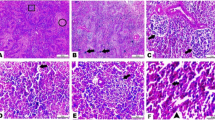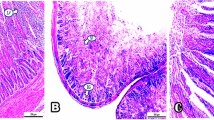Abstract
Zinc is an essential nutritional trace mineral required for growth and health. The aim of the current work is to compare the effects of bulk zinc oxide and zinc oxide nanoparticles (ZnO-NPs) on the growth performance, feeding behavior, and zinc residues in tissues with the associated histopathological alterations in chicken. Meanwhile, the antibacterial activity against the isolated E. coli O78 strain was evaluated. Ninety Hubbard one-day-aged broiler chicks were divided into 3 groups, 30 each: birds of the 1st group fed a basal ration, those of the 2nd group fed a ration containing zinc oxide at a dose of 3000 mg/kg diet, and chicks of the 3rd group are given a ration containing ZnO-NPs at a dose of 90 mg/kg diet from 2 to 20 days age. The experiment lasted for 35 days. Feed choice test was done at the 3rd week of age on another 12 birds. Results revealed that birds fed with ZnO-NPs showed an improvement in body weight compared with the zinc oxide-administered group. There was no reluctance from birds to both diets supplemented with either zinc oxide or ZnO-NPs, with a constant preference to ZnO-NPs diet throughout the 5-min test. The highest levels of zinc were detected in the livers, kidneys, lungs, and muscles in the 1st day following cessation of drug administration. There was no significant effect on the levels of creatinine, uric acid, AST, and ALT. Mild to moderate degenerative changes as well as necrosis could be detected in the livers and hearts following both treatments. In conclusion, nano-zinc oxide could be practically used in broiler feed at a dose of 90 mg/kg diet instead of bulk zinc oxide, at a dose of 3000 mg/kg diet, with an improved body weight. Both supplements caused no significant effects on serum parameters and had the same antibacterial activity against E. coli O78.





Similar content being viewed by others
References
Ahmadi F, Ebrahimnezhad Y, Sis MN, Ghalehkandi GJ (2013) The effects of ZnO-NPs on performance, digestive organs and serum lipid concentrations in broiler chickens during starter period. Int J Biosci 3:23–29
Amara S, Slama IB, Mrad I, Rihane N, Khemissi W, El Mir L, Rhouma KB, Abdelmelek H, Sakly M (2014) Effects of zinc oxide nanoparticles and/or zinc chloride on biochemical parameters and mineral levels in rat liver and kidney. Hum Exp Toxicol 33(11):1150–1157
Asheer M, Manwar SJ, Gole MA, Sirsat S, Wade MR, Khose KK, Sajid Ali S (2018) Effect of dietary nano zinc oxide supplementation on performance and zinc bioavailability in broilers. Indian J Poult Sci 53(1):70–75; Research Article. https://doi.org/10.5958/0974-8180.2018.00004.1
Azam A, Ahmed AS, Oves M, Khan MS, Habib SS, Memic A (2012) Antimicrobial activity of metal oxide nanoparticles against gram-positive and gram-negative bacteria: a comparative study. Int J Nanomedicine 7:6003–6009
Bancroft J, Gamble M (2008) Theory and practice of histological techniques, 6th edn. Churchill Livingstone Elsevier, Philadelphia
Brooks MA, Grimes JL, Lloyd KE, Verissimo S, Speers JW (2013) Bioavailability in chicks of zinc from zinc propionate. J Appl Poultr Res 22:153–159
Chagneau AM, Bessonneau D, Bouchot C, Lescoat P, Picard M, Lessire M (2006) Broiler short-term feed preferences measured with SRAbox, a new feed choice procedure. Poult Sci 85:808–815
Chen J, Tan M, Nemmar A, Song W, Dong M, Zhang G, Li Y (2006) Quantification of extrapulmonary translocation of intratracheal-instilled particles in vivo in rats: effect of lipopolysaccharide. Toxicology 222:195–201
Collee CJ, Marmion BP, Fraser AG, Simmons A (1996) Cited in Mackie & Mccartney Practical medical microbiology, 4th edition page 151–178. New York EclinBurgh London
Davin R, Manzanilla EG, Figueroa J, SoláOriol D et al. (2011) Evaluation of the palatability of zinc oxide and zinc sulphate in the piglets diet. http://agris.fao.org/agrissearch/search.do?recordID=ES2011000280
European Commission (2003) Opinion of the Scientific Committee for Animal Nutrition on the use of zinc in feeding stuffs. HEALTH & CONSUMER PROTECTION DIRECTORATE-GENERAL Directorate C - Scientific Opinions C2 - Management of scientific committees; scientific co-operation and networks
Fossati P, Prencipe L, Berti G (1980) Use of 3,5-dichloro-2-hydroxybenzenesulfonic acid/4-aminophenazone chromogenic systems in direct enzymatic assay of uric acid in serum and urine. Clin Chem 26:227–231
Fujihara J, Tongu M, Hashimoto H, Fujita Y, Nishimoto N, Yasuda T, Takeshita H (2015) Pro-inflammatory responses and oxidative stress induced by ZnO nanoparticles in vivo following intravenous injection. Eur Rev Med Pharmacol Sci 19:4920–4926
FVE (Federation of Veterinarians of Europe) (2014) FVE position paper on the use of zincoxide.FVE/14/doc/016. https://www.knmvd.nl/.../016_fve_opinion_on_zinkoxide_adopted
Houot O (1985) In: Siest G, Henny J, Young DS (eds) Interpretation of clinical laboratory tests. Biochemical Publications, pp 220–234
Hu CH, Qian ZC, Song J, Luan ZS, Zuo AY (2013) Effects of zinc oxide-montmorillonite hybrid on growth performance, intestinal structure, and function of broiler chicken. Poultry 92:143–150
Hussein GAM, Khedr MH, Farghali AA (2002) Gadolinium oxide from gadolinium oxalate hydrate physicochemical characterization. Colloids Surf A Physicochem Eng Asp 203(1–3):137–142
Idowu OMO, Ajuwon RO, Oso AO, Akinloye OA (2011) Effects of zinc supplementation on laying performance, serum chemistry and Zn residue in tibia bone, liver, excreta and egg shell of laying hens. Int J Poult Sci 10:225–230
Iqbal A, Navarro M, Roura E (2018) Effectiveness of a double choice test to assess dietary taste preferences in broilers. https://zootecnicainternational.com/featured/effectiveness-double-choice-test-assess-dietary-taste-preferences-broiler-chickens-2/. Accessed 13 March 2018
Khan RU, Rahman ZU, Javed I, Muhammad F (2014) Effect of vitamins, protein level and probiotics on immune response of moulted male broilers. J Anim Physiol Anim Nutr 98(4):620–627. https://doi.org/10.1111/jpn.12087
Khedr MH, Farghali AA (2005) Physicochemical properties of nanocrystallite copper ferrite prepared by a novel self-flash combustion of acetate precursors. J Mater Sci Technol 21(5):675–680
Kim WK, Patterson PH (2005) Effects of dietary zinc supplementation on hen performance, ammonia volatilization, and nitrogen retention in manure. J Environ Sci Health B 40:675–686
Li CH, Shen CC, Cheng YW, Huang SH, Wu CC, Kao CC, Liao JW, Kang JJ (2012) Organ biodistribution, clearance, and genotoxicity of orally administrated zinc oxide nanoparticles in mice. Nanotoxicology 6:746–756. https://doi.org/10.3109/17435390.2011.620717
Liu Y, He L, Mustapha A, Li H, Hu ZQ, Lin M (2009) Antibacterial activities of zinc oxide nanoparticles against Escherichia coli O157:H7. J Appl Microbiol 107:1193–1201
Luciane RS, Viégas J, Freitas LS, Brondani IL, Argenta FM et al (2011) Behavior patterns of cows with Charolais or Nellore breed predominance fed diets with plant extract or monensin sodium. Rev Bras Zootec l40(12):2954–2962
Machebe NS, Iweh P, Onyimonyi AE, Ekere OS, Abonyi F (2013) Zinc oxide as an effective mineral for induced moulting: effects on post moult performance of laying hens in the humid tropics. J Vet Sci Technol S11:003. https://doi.org/10.4172/2157-7579.S11-003
Mahmoud UT, Abdel-Mohsein HS, Mahmoud MAM et al (2020) Effect of zinc oxide nanoparticles on broilers’ performance and health status. Trop Anim Health Prod. https://doi.org/10.1007/s11250-020-02229-2
Mavromichalis I, Peter CM, Parr TM, Ganessunker D, Baker DH (2000) Growth-promoting efficacy in young pigs of two sources of zinc oxide having either a high or a low bioavailability. J Anim Sci 78:2896–2902
NRC - National Research (1994) Council. Nutrient requirements of poultry.9thed.Washington: National Academic
Petrovic V, Nollet L, Kovac G (2010) Effect of dietary supplementation of trace elements on the growth performance and their distribution in the breast and thigh muscles depending on the age of broiler chickens. Acta Vet Brno 79:203–209
Picard M, Plouzeau M, Faure JM (1999) A behavioural approach to feeding broilers. Ann Zootech 48:233–245
Picard M, Le Fur C, Melcion J-P, Bouchot C (2000) Feed particles: what chickens see and touch. Productions Animales -Paris- Institut National de la RechercheAgronomique 13(2):117–130
Pousga S, Boly H, Ogle B (2005) Choice feeding of poultry: a review. Livest Res Rural Dev 17(4). http://www.lrrd.org/lrrd17/4/pous17045.htm. Accessed 1 April 2005
Qian JL (2011) The surface properties and photocatalytic activities of ZnO ultrafine particles. Appl Surf Sci 180:308–314
Raghupathi KR, Koodali RT, Manna AC (2011) Size-dependent bacterial growth inhibition and mechanism of antibacterial activity of zinc oxide nanoparticles. Langmuir. 5(27):4020–4028
Ramiah SK, Awad EA, Mookiah S, Idrus Z (2019) Effects of zinc oxide nanoparticles on growth performance and concentrations of malondialdehyde, zinc in tissues, and corticosterone in broiler chickens under heat stress conditions. Poult Sci 0:1–11. https://doi.org/10.3382/ps/pez093
Reitman S, Frankel S (1957) A colorimetric method for the determination of serum glutamic oxaloacetic and glutamic pyruvic transaminases. Am J Clin Pathol 28:56–63. https://doi.org/10.1093/ajcp/28.1.56
Reynolds FH, Forbes JM, Miller HM (2010) Does the newly weaned piglet select a zinc oxide supplemented feed, when given the choice? Animal 4(8):1359–1367. https://doi.org/10.1017/S1751731110000327
Salim HM, Lee HR, Jo C, Lee SK, Lee BD (2012) Effect of sex and dietary organic zinc on growth performance, carcass traits, tissue mineral content, and blood parameters of broiler chickens. Biol Trace Elem Res 147:120–129
Saman S, Moradhaseli S, Shokouhian A, Ghorbani M (2013) Histopathological effects of ZnO nanoparticles on liver and heart tissues in Wistar rats. Adv Biores 4:83–88
Sarvari BGI, Seyedi AHII, Shahryar HAI, Sarikhan MI and Ghavidel SZI (2015) Effects of dietary zinc oxide and a blend of organic acids on broiler live performance, carcass traits, and serum parameters. Brazilian Journal of Poultry Science. Special Issue, Nutrition-Poultry Feeding Additives: 039–046 https://doi.org/10.1590/1516-635x
Seil JT, Webster TJ (2012) Antibacterial effect of zinc oxide nanoparticles combined with ultrasound. Nanotechnology 23(49):495101. https://doi.org/10.1088/0957-4484/23/49/495101
Su YK, Peng SM, Ji LW et al (2009) Ultraviolet ZnO nano rod photosensors. Langmuir 26:603–606
Tian L, Zhu FH, Ren HY, Jiang JY, Li W (2009) Effect of nano-zinc oxide on antioxidant function in broilers. Chin J Anim Nutr 21:534–539
Varun A, Karthikeyan N, Muthusamy P, Raja A, Vijayarani K, Saranya S (2018) Effect of zinc oxide and zinc oxide nano particles on performance, carcass characteristics and metallotheionine (MTmRNA) expression in broiler chicken. Indian J Poult Sci 53(3):318–323
Watson CY, Molina RM, Louzada A, Murdaugh KM, Donaghey TC, Brain JD (2015) Effects of zinc oxide nanoparticles on Kupffer cell phagosomal motility, bacterial clearance, and liver function. Int J Nanomedicine 10:4173–4184. https://doi.org/10.2147/IJN.S82807
Xie Y, He Y, Irwin PL, Jin T, Shi X (2011) Antibacterial activity and mechanism of action of zinc oxide nanoparticles against Campylobacter jejuni. Appl Environ Microbiol 77:2325–2331
Zaboli K, Aliarabi H, Bahari AA, Abbasalipourkabir R (2013) 2013 Role of dietary nano-zinc oxide on growth performance and blood levels of mineral: A study on in Iranian Angora (Markhoz) goat kids. J Pharm Health Sci 2(1):19–26
Zchelz Z, Moinar J, Hohmann J (2006) Antimicrobial and antiplasmid activities of essential oils. Fitoterapia 77:279–285
Zhao C, Tan S, Xiao X, Qiu X, Pan J, Tang Z (2014) Effects of dietary zinc oxide nanoparticles on growth performance and antioxidative status in broilers. Biol Trace Elem Res 160:361–367. https://doi.org/10.1007/s12011-014-0052-2
Zheng W, Jian YM, Zehang Y, Jiang W, Wang X, Cowan DM (2009) Chelation therapy of manganese intoxication with para amino salicylic acid in Sprague-Dawley rats. Toxicol Sci 54:295–301
Author information
Authors and Affiliations
Corresponding author
Additional information
Responsible editor: Mohamed M. Abdel-Daim
Publisher’s note
Springer Nature remains neutral with regard to jurisdictional claims in published maps and institutional affiliations.
Rights and permissions
About this article
Cite this article
Radi, A.M., Abdel Azeem, N.M. & EL-Nahass, ES. Comparative effects of zinc oxide and zinc oxide nanoparticle as feed additives on growth, feed choice test, tissue residues, and histopathological changes in broiler chickens. Environ Sci Pollut Res 28, 5158–5167 (2021). https://doi.org/10.1007/s11356-020-09888-6
Received:
Accepted:
Published:
Issue Date:
DOI: https://doi.org/10.1007/s11356-020-09888-6




